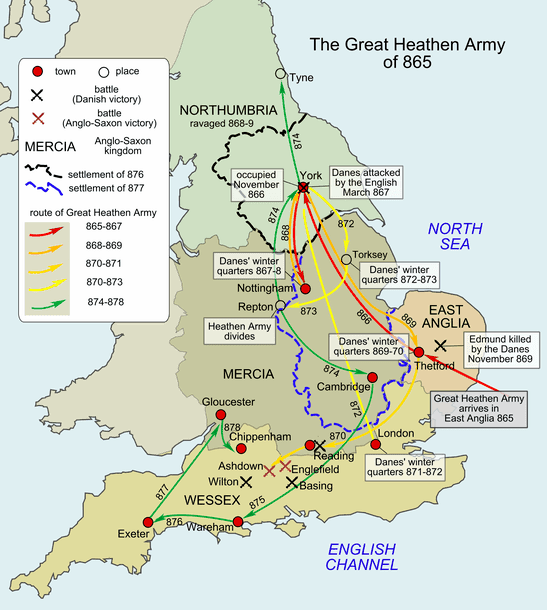 | ||
Similar Byzantine army, Late Roman army, Royal Danish Army | ||
Vikings the great heathen army attacks king aelle s army season 4b official scene 4x18 hd
The Great Viking Army or Great Danish Army, known by the Anglo-Saxons as the Great Heathen Army (OE: mycel hæþen here), was a coalition of Norse warriors, originating from Denmark (and likely also from Sweden and Norway) who came together under a unified command to invade the four Anglo-Saxon kingdoms that constituted England in AD 865.
Contents
- Vikings the great heathen army attacks king aelle s army season 4b official scene 4x18 hd
- Great heathen army appears in northumbria vikings 4x18
- Background
- The size of the army
- Invasion of England
- Start of the invasion 865
- King Alfreds victory
- Aftermath
- References
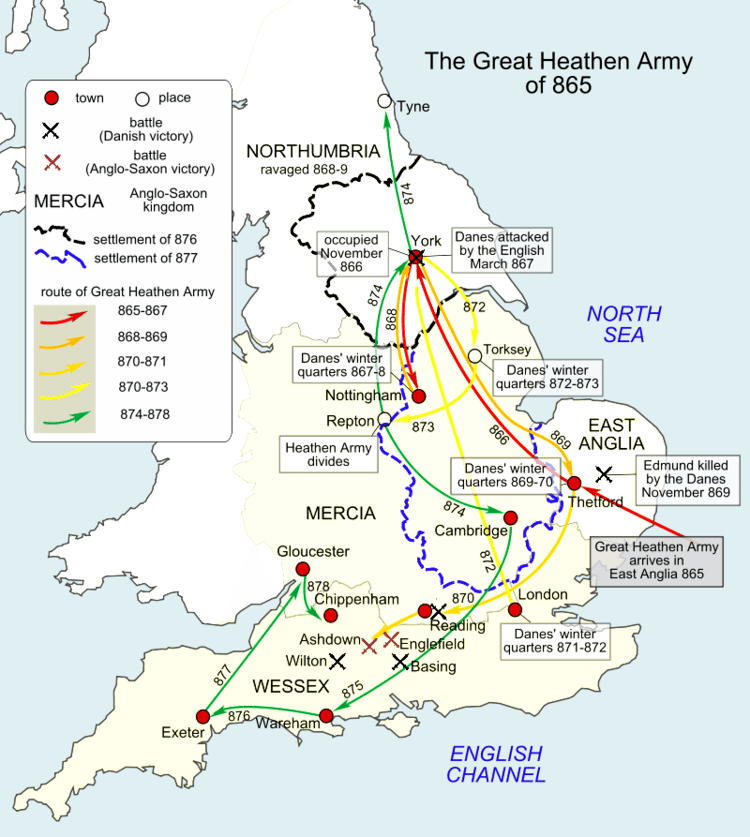
Since the late 8th century, the Vikings had settled for mainly "hit-and-run" raids on centres of wealth, such as monasteries. However, the intent of the Great Army was different. It was much larger than the usual raiding party and its purpose was to conquer.
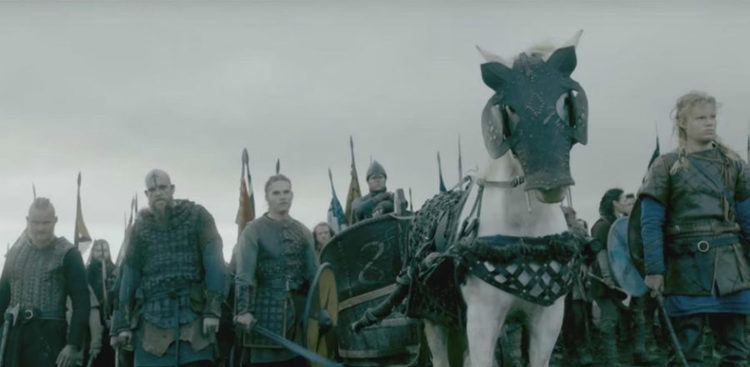
The name Great Heathen Army is derived from the Anglo-Saxon Chronicle of 865. Legend has it that the force was led by three sons of Ragnar Lodbrok. The campaign of invasion and conquest against the four remaining Anglo-Saxon kingdoms lasted 14 years. Unlike many of the Scandinavian raiding armies of the period, surviving sources give no firm indication of its numbers, but it was clearly amongst the largest forces of its kind.
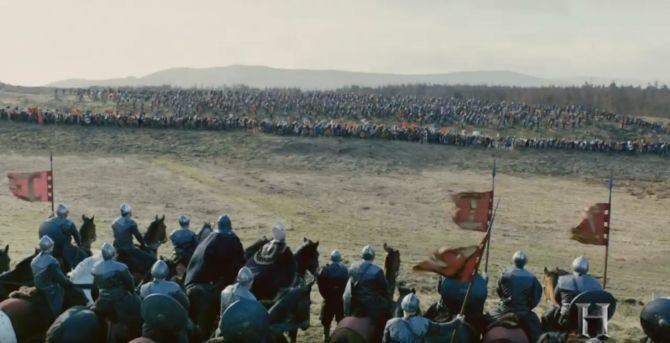
The invaders initially landed in East Anglia, where the king provided them with horses for their campaign in return for peace. They spent the winter of 865–66 at Thetford, before marching north to capture York in November 866. York had been founded as the Roman legionary fortress of Eboracum and revived as the Anglo-Saxon trading port of Eoforwic.
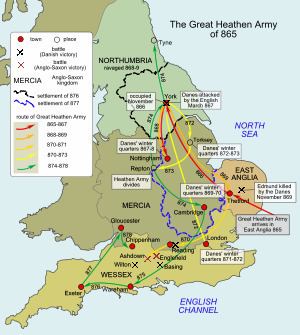
During 868, the army marched deep into Mercia and wintered in Nottingham, where it was besieged by a joint force from the kingdoms of Mercia and Wessex. With no progress being made, the Mercians agreed to terms with the Viking army, which moved back to York for the winter of 869–70. In 870, the Great Army returned to East Anglia, conquering it and killing its king. The army moved to winter quarters in Thetford. In 871, the Vikings moved on to Wessex, where Alfred the Great was content to pay them to leave. The army then marched to London to overwinter in 872 before moving back to Northumbria in 873. It again returned to Mercia, conquering it in 874 and overwintering at Repton on the River Trent. By this time, only the kingdom of Wessex had not been conquered by the invading Vikings. It was towards the end of 875 when the army started their second invasion of Wessex. After a few setbacks, Alfred the Great defeated the Vikings at the Battle of Edington, and a treaty was agreed upon, whereby the Vikings were able to remain in control of much of northern and eastern England.
Great heathen army appears in northumbria vikings 4x18
Background
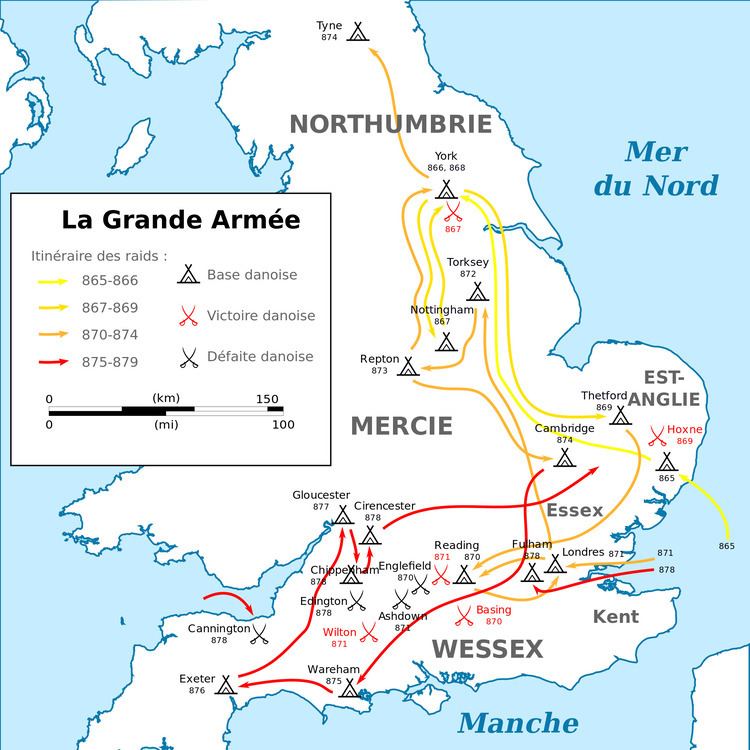
Viking raids began in England in the late 8th century, primarily on monasteries. The first monastery to be raided was in 793 at Lindisfarne, off the northeast coast; the Anglo-Saxon Chronicle described the Vikings as "heathen men". Monasteries and minster churches were popular targets as they were wealthy and had valuable objects that were portable. The Anglo-Saxon Chronicle for the year 840 says that Æthelwulf of Wessex was defeated at Carhampton, Somerset, after 35 Viking ships had landed in the area. The Annals of St. Bertin also reported the incident, stating:
The Northmen launched a major attack on the island of Britain. After a battle lasting three days, the Northmen emerged the winners – plundering, looting, slaughtering everywhere. They wielded power over the land at will.
Despite this setback, Æthelwulf did have some success against the Vikings. The Anglo-Saxon Chronicle has repeated references during his reign of victories won by ealdormen with the men of their shires. However, the raiding of England continued on and off until the 860s, when instead of raiding, the Vikings changed their tactics and sent a great army to invade England. This army was described by the Anglo-Saxon Chronicle as a "Great Heathen Army" (OE: mycel hæþen here or mycel heathen here).
The size of the army
Historians provide varying estimates for the size of the Great Heathen Army. According to the 'minimalist' scholars, such as Pete Sawyer, the army may have been smaller than traditionally thought. Sawyer notes that the Anglo-Saxon Chronicle of 865 referred to the Viking force as a Heathen Army, or in Old English "hæþen here".
The law code of King Ine of Wessex, issued in about 694, provides a definition of here as "an invading army or raiding party containing more than thirty five men", thus differentiating between the term for the invading Viking army and the Anglo-Saxon army that was referred to as the fyrd. The scribes who wrote the Anglo-Saxon Chronicle used the term here to describe the Viking forces. The historian Richard Abels suggested that this was to differentiate between the Viking war bands and those of military forces organised by the state or the crown. However, by the late 10th and early 11th century, here was used more generally as the term for army, whether it was Viking or not.
Sawyer produced a table of Viking ship numbers, as documented in the Anglo-Saxon Chronicle, and assumes that each Viking ship could carry no more than 32 men, leading to his conclusion that the army would have consisted of no more than 1,000 men. Other scholars give higher estimates. For example, Laurent Mazet-Harhoff observes that many thousands of men were involved in the invasions of the Seine area. However, Mazet-Harhoff does say that the military bases that would accommodate these large armies have yet to be rediscovered. Guy Halshall reported that, in the 1990s, several historians suggested that the Great Heathen Army would have numbered in the low thousands; however, Halshall advises that there "clearly is still much room for debate".
The army probably developed from the campaigns in France. In Francia, there was a conflict between the Emperor and his sons, and one of the sons had welcomed the support from a Viking fleet. By the time that the war had ended, the Vikings had discovered that monasteries and towns situated on navigable rivers were vulnerable to attack. In 845, a raid on Paris was prevented by the large payment of silver to the Vikings. The opportunity for rich pickings drew other Vikings to the area, and by the end of the decade all the main rivers of West Francia were being patrolled by Viking fleets. In 862, the West Frankish king responded to the Vikings, fortifying his towns and defending his rivers, thus making it difficult for the Vikings to raid inland. The lower reaches of the rivers and the coastal regions were left largely undefended. Religious communities in these areas, however, chose to move inland away from the reaches of the Viking fleets. With the changes in Francia making raiding more difficult, the Vikings turned their attention to England.
Invasion of England
The term vikingr simply meant pirate, and the Viking heres may well have included fighters of other nationalities than Scandinavians. The Viking leaders would often join together for mutual benefit and then dissolve once profit had been achieved. Several of the Viking leaders who had been active in Francia and Frisia joined forces to conquer the four kingdoms constituting Anglo-Saxon England. The composite force probably contained elements from Denmark, Norway, Sweden and Ireland as well as those who had been fighting on the continent. The Anglo-Saxon historian Æthelweard was very specific in his chronicle and said that "the fleets of the viking tyrant Hingwar landed in England from the north".
The bulk of the army consisted of Danish and Norwegian Vikings, who, prior to the invasion, would have been raiding Francia and Frisia. Some of the grave goods unearthed at Repton, where the Great Heathen Army spent the winter in 874, were of Norwegian origin, indicating that part of the army was likely to have contained elements of Norwegian Vikings, who would have been operating in Britain, raiding and conquering lands around the Irish Sea. The Great Heathen Army would also have consisted of various independent bands, or liðs, coming together under a joint leadership.
The Vikings had been defeated by the West Saxon King Æthelwulf in 851, so rather than land in Wessex they decided to go further north to East Anglia. Legend has it that the united army was led by the three sons of Ragnar Lodbrok: Halfdan Ragnarsson, Ivar the Boneless (Hingwar), and Ubba. Norse sagas consider the invasion by the three brothers as a response to the death of their father at the hands of Ælla of Northumbria in 865, but the historicity of this claim is uncertain.
Start of the invasion, 865
In late 865, the Vikings landed in East Anglia and used it as a starting point for an invasion. The East Anglians made peace with the invaders by providing them with horses. The Vikings stayed in East Anglia for the winter before setting out for Northumbria towards the end of 866, establishing themselves at York. In 867, the Northumbrians paid them off, and the Viking Army established a puppet leader in Northumbria before setting off for the Kingdom of Mercia, where in 867 they captured Nottingham. The king of Mercia requested help from the king of Wessex to help fight the Vikings. A combined army from Wessex and Mercia besieged the city of Nottingham with no clear result, so the Mercians settled on paying the Vikings off. The Vikings returned to Northumbria in autumn 868 and overwintered in York, staying there for most of 869. They returned to East Anglia and spent the winter of 869–70 at Thetford. There was no peace agreement between the East Anglians and the Vikings this time. When the local king Edmund fought against the invaders, he was captured and killed.
In 871, the Great Summer Army arrived from Scandinavia, led by Bagsecg. The reinforced Viking army turned its attention to Wessex, but the West Saxons, led by King Æthelred's brother Alfred, defeated them on 8 January 871 at the Battle of Ashdown, slaying Bagsecg in the process. Three months later, Æthelred died and was succeeded by Alfred (later known as Alfred the Great), who bought the Vikings off to gain time. During 871–72, the Great Heathen Army wintered in London before returning to Northumbria. It seems that there had been a rebellion against the puppet ruler in Northumbria, so they returned to restore power. They then established their winter quarters for 872-73 at Torksey in the Kingdom of Lindsey (now part of Lincolnshire). The Mercians again paid them off in return for peace, and at the end of 873 the Vikings took up winter quarters at Repton in Derbyshire.
In 874, following their winter stay in Repton, the Great Heathen Army drove the Mercian king into exile and finally conquered Mercia; the exiled Mercian king was replaced by Ceowulf. According to Alfred the Great's biographer Asser, the Vikings then split into two bands. Halfdan led one band north to Northumbria, where he overwintered by the river Tyne (874–75). In 875 he ravaged further north to Scotland, where he fought the Picts and the Britons of Strathclyde. Returning south of the border in 876, he shared out Northumbrian land amongst his men, who "ploughed the land and supported themselves"; this land was part of what became known as the Danelaw.
King Alfred's victory
According to Asser, the second band was led by Guthrum, Oscetel, and Anwend. This group also left Repton in 874 and established a base at Cambridge for the winter of 874–75. In late 875 they moved onto Wareham, where they raided the surrounding area and occupied a fortified position. Asser reports that Alfred made a treaty with the Vikings to get them to leave Wessex. The Vikings left Wareham, but it was not long before they were raiding other parts of Wessex, and initially they were successful. Alfred fought back, however, and eventually won victory over them at the Battle of Edington in 878. This was followed closely by what was described by Asser as the Treaty of Wedmore, under which England was divided between the Anglo-Saxons of Wessex and the Vikings. Guthrum also agreed to be baptised.
Aftermath
In late 878, Guthrum's band withdrew to Cirencester, in the kingdom of Mercia. Then, probably in late 879, it moved to East Anglia, where Guthrum, who was also known by his baptismal name of Aethelstan, reigned as king until his death in 890.
The part of the army that did not go with Guthrum mostly went on to more settled lives in Northumbria and York. Some may have settled in Mercia. Evidence for this is the presence of two Viking cemeteries in modern-day Derbyshire that are believed to be connected to the Great Army, at Repton and at Heath Wood.
Excavations at the Anglo-Saxon monastery of Repton in the heart of Mercia between 1974–88 found a D-shaped earthwork on the river bank, incorporated into the stone church. Burials of Viking type were made at the east end of the church, and an existing building was cut down and converted into the chamber of a burial mound that revealed the disarticulated remains of at least 249 people, with their long bones pointing towards the centre of the burial. A large stone coffin was found in the middle of the mass grave; however, the remains of this individual did not survive. A study of the skeletal remains revealed that at least 80% of the individuals were male, and were between the ages of 15 and 45. Further investigation of the male skeletal remains revealed that they were dissimilar to the local population of Repton, and most likely of Scandinavian descent. In contrast, analysis of the female remains revealed that they were similar to the local population, suggesting an Anglo-Saxon lineage. It is possible that the people in the grave may have suffered some sort of epidemic when the army overwintered in Repton during 873–74, leading to the mass burial. The nearby cemetery at Heath Wood barrow cemetery contains about sixty cremations (rather than burials). Finds of cremation sites in the British Isles are very rare, and this one probably was the war cemetery of the Great Heathen Army.
In 878, a third Viking army gathered on the Thames. It seems they were partly discouraged by the defeat of Guthrum but also Alfred's success against the Vikings coincided with a period of renewed weakness in Francia. The Frankish emperor, Charles the Bald, died in 877 and his son shortly after, precipitating a period of political instability of which the Vikings were quick to take advantage. The assembled Viking army on the Thames departed in 879 to begin new campaigns on the continent.
The rampaging Viking army on the continent encouraged Alfred to protect his Kingdom of Wessex. He built a navy, reorganised the army, and set up a system of fortified towns known as burhs. He mainly used old Roman cities for his burhs, as he was able to rebuild and reinforce their existing fortifications. Historically, every freeman in the land could be called out to protect the realm in times of trouble. However, the speed of Viking hit-and-run raids had been too quick for the local militias to act, so part of Alfred's reforms were to create a standing army that could react rapidly to attacks. The Anglo-Saxon rural population lived within a 24 km (15-mile) radius of each burh, so they were able to seek refuge when necessary. To maintain the burhs, as well as the standing army, Alfred set up a system of taxation and conscription that is recorded in a document now known as the Burghal Hidage. The burhs were interconnected with a network of military roads, known as herepaths, enabling Alfred's troops to move swiftly to engage the enemy. Some historians believe that each burh would have had a mounted force that would be ready for action against the Vikings.
By 896, the remains of the Danish army that had not gone to East Anglia or Northumbria found it difficult to make any progress in Alfred's fortified kingdom, so according to the Anglo-Saxon Chronicle those that were penniless found themselves ships and went south across the sea to the Seine. As for Anglo-Saxon England, it had been torn apart by the invading Great Heathen Army, and the Vikings were now in control of northern and eastern England, while Alfred and his successors remained in control of Wessex.
